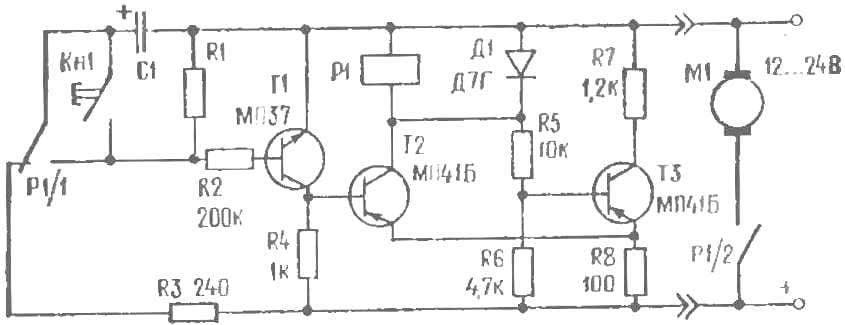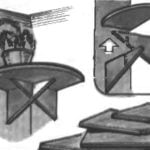 The competition modelers often possible to observe such picture: running at a relatively high speed model, the participants caught on the fly from the boat. Often this operation leads to breakage. And the battery is wasted after passing the course.
The competition modelers often possible to observe such picture: running at a relatively high speed model, the participants caught on the fly from the boat. Often this operation leads to breakage. And the battery is wasted after passing the course.
A simple automatic device time relay installed on the model, will shut off a running motor after a specified period of time. Here’s how it works.
The capacitor C1 (see diagram) is charged up to a voltage of the power source. If you click KN1, he begins to discharge through resistor R1 and transistor T1 opens. The voltage drop at resistor R4 triggers the Schmitt trigger transistors T2 and T3.
In the initial state, locked in T2 and T3 open. The current flowing through the transistor T3 causes a voltage drop across the resistor R8 keeps transistor T2 in the closed state. When the negative voltage on resistor R4 increases, the transistor T2 opens and the relay R1 is activated. Its contact R1/2 it includes the motor model.

Schematic diagram of the time relay.
As the capacitor C1 is discharged, the transistors T1 and T2 begin to close and the resistor Rб there is a negative potential. As a result, the transistor T3 is opened, which in turn leads to the final locking T2 and de-energize relay R1. Its contact R1/2, it breaks the supply circuit of the engine.
The values of resistors R5, R6 of the voltage divider is selected so that when you open the transistor T2 the voltage across resistors R8 and Rб differed from each other by 0.2—0.3 V. If the capacitance of the capacitor C1 is 400 microfarads, and the resistance of resistor R1—1 MW, exposure time of the relay is 1 min. (the battery Voltage is 24V.) Changing the nominal znachennya C1 and R1, select the desired exposure time.
I. SHESTAKOV, Novopolotsk, Vitebskaya oblast



